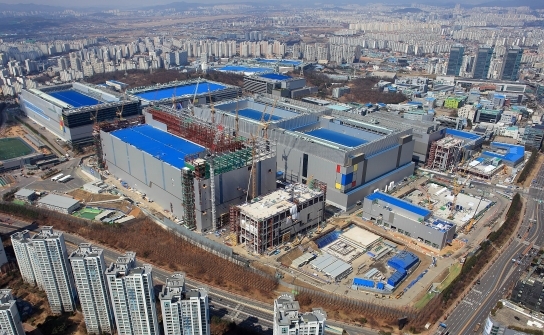South Korea to double down on non-memory chips
Moon visits Samsung plant as ministries decide to jointly inject a combined W1tr
By Shin Ji-hyePublished : April 30, 2019 - 15:59
South Korea, the world’s top memory chip provider, aims to rise to an unrivaled position in both memory and non-memory semiconductor industry by 2030, President Moon Jae-in said Tuesday as he visited a Samsung facility, unveiling a set of policy measures worth over 1 trillion won ($860 million) to support industry players.
The president made the announcement titled “System Semiconductor Vision and Strategy,” as Samsung Electronics Vice Chairman Lee Jae-yong looked on along with some 280 participants representing other semiconductor businesses, academia and politics, at Samsung’s semiconductor business headquarters in Hwaseong, Gyeonggi Province.
“Our goal is clear,” Moon said. “It is to make Korea a general semiconductor powerhouse by expanding its market share to 10 percent in the fabless sector by 2030.”
The president stressed the government will focus on investing in talent and technology by expanding national research and development resources for the non-memory sector.
“Samsung has announced its goal of becoming the world’s No.1 non-memory chipmaker by investing 133 trillion won by 2030,” Moon said. “The government applauds Samsung for its grand ambition and will proactively support it.” The president also praised Korean tech giant’s shipments of logic chips produced on the latest 7-nanometer EUV process technology, the first among global foundry businesses.
Lee accompanied the president’s tour of some of the main production facilities, including the construction site of a new extreme ultraviolet line that will be the key facility for upcoming system chips.
The president made the announcement titled “System Semiconductor Vision and Strategy,” as Samsung Electronics Vice Chairman Lee Jae-yong looked on along with some 280 participants representing other semiconductor businesses, academia and politics, at Samsung’s semiconductor business headquarters in Hwaseong, Gyeonggi Province.
“Our goal is clear,” Moon said. “It is to make Korea a general semiconductor powerhouse by expanding its market share to 10 percent in the fabless sector by 2030.”
The president stressed the government will focus on investing in talent and technology by expanding national research and development resources for the non-memory sector.
“Samsung has announced its goal of becoming the world’s No.1 non-memory chipmaker by investing 133 trillion won by 2030,” Moon said. “The government applauds Samsung for its grand ambition and will proactively support it.” The president also praised Korean tech giant’s shipments of logic chips produced on the latest 7-nanometer EUV process technology, the first among global foundry businesses.
Lee accompanied the president’s tour of some of the main production facilities, including the construction site of a new extreme ultraviolet line that will be the key facility for upcoming system chips.

Timed with the event, the Ministry of Trade, Industry and Energy unveiled a set of policy measures including around 1 trillion won worth financial support for the non-memory sector.
To boost the industry, the Ministry of Trade, Industry and Energy and the Ministry of Science and ICT plan to jointly inject funds over the next decade. The Industry Ministry has set aside 520 billion won and the ICT Ministry plans to invest the rest.
The funds will be used to develop key original and application technologies of next-generation chips that will lead the future industries, including artificial intelligence, automobiles, bio, energy and robots. The next-generation chips, for instance, include AI chips for smart city and big data, automobile chips that improve battery efficiency of electric cars by more than 10 times and energy chips that transform natural energy into electric energy.
The plan comes 1 1/2 months after President Moon ordered such measures to enhance the relatively weak non-memory industry at a state affairs meeting held on March 19.
To be in harmony with the government, Samsung had announced last week a 133 trillion won investment plan to strengthen its system chip and foundry businesses over the next 10 years.
“With the US companies capturing 70 percent market share in the non-memory sector and countries like Taiwan and China fast growing, if (Korea) loses its golden time, even the local market could be taken by foreign makers,” Industry Minister Sung Yun-mo told reporters during a press briefing on Monday, explaining as to why the government has decided to back the industry.
While Korean chipmakers are dominating the global memory market with a 60 percent share, their share in logic chips is merely 3 percent to 4 percent despite fast-growing demand for the advanced chip processors that can power self-driving cars, AI-enabled devices and internet of things home appliances.
The government will also support the creation of demand for small local fabless and foundry companies to grow. A fabless company designs chips and a foundry manufactures the chips.

“The most important thing for the nation’s non-memory industry to grow is the creation of demand,” Sung said. The government’s past efforts to boost the sector have not paid off because the support did not focus on the entire eco-system of the non-memory chip industry, he explained.
The ministry plans to create demand through the formation of an alliance of the government, client companies, fabless firms and research organizations so they can jointly work from the creation of demand and technology planning to research and development.
The alliance will be formed in the areas of automobiles, bio, energy, IoT-based home appliances and robots. The clients include Korean large companies and state-run corporations, including Hyundai Mobis, LG Electronics, Korea Electric Power Corp., Korea Gas Corp. and Hyundai Robotics.
Demand for logic chips will also be created in the public sectors of energy, safety, national defense and transportation infrastructure. A cooperative system will be built between public organizations and fabless firms so that they can jointly work on demand creation, planning, technology development and public procurement.
The government also plans to enable fabless firms to participate in fifth-generation network-related public projects, such as 5G service demonstration, smart social overhead capital projects and smart cities.
Through the support, Korea aims to expand its foundry market share from the current 16 percent to 35 percent by 2030, becoming the world’s largest foundry provider. Currently, the global market is dominated by Taiwanese company TSMC with a 48 percent share.
As for fabless, the nation aims to capture a 10 percent share from the current 1.6 percent share. The US companies, including Qualcomm and Nvidia, are now leading the market with around 70 percent share.
By Song Su-hyun and Shin Ji-hye
(song@heraldcorp.com), (shinjh@heraldcorp.com)









![[Hello India] Hyundai Motor vows to boost 'clean mobility' in India](http://res.heraldm.com/phpwas/restmb_idxmake.php?idx=644&simg=/content/image/2024/04/25/20240425050672_0.jpg&u=)










